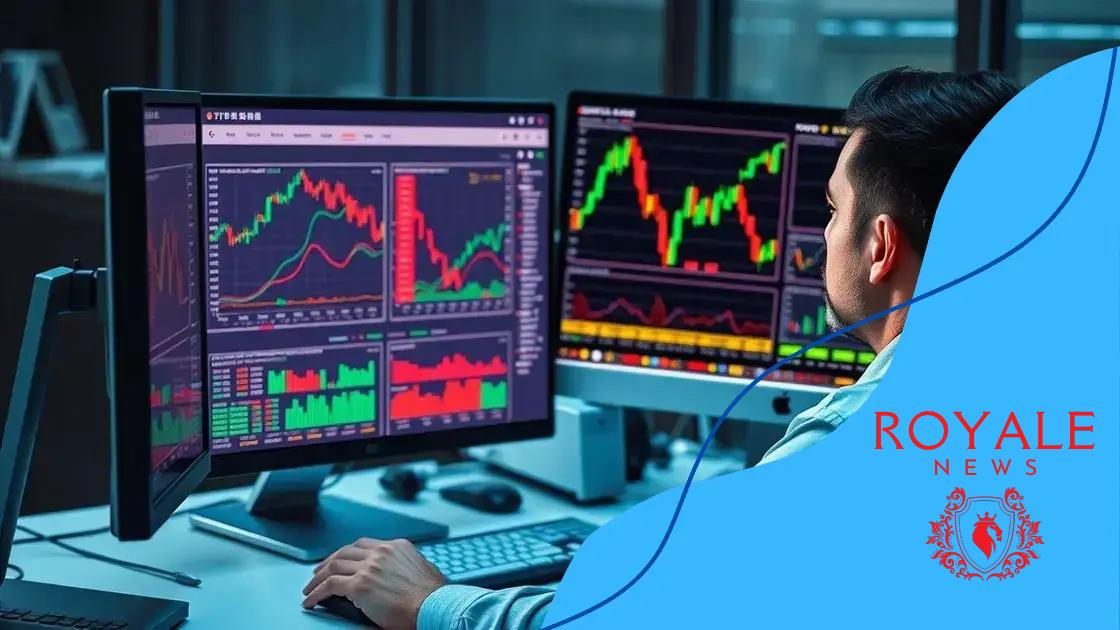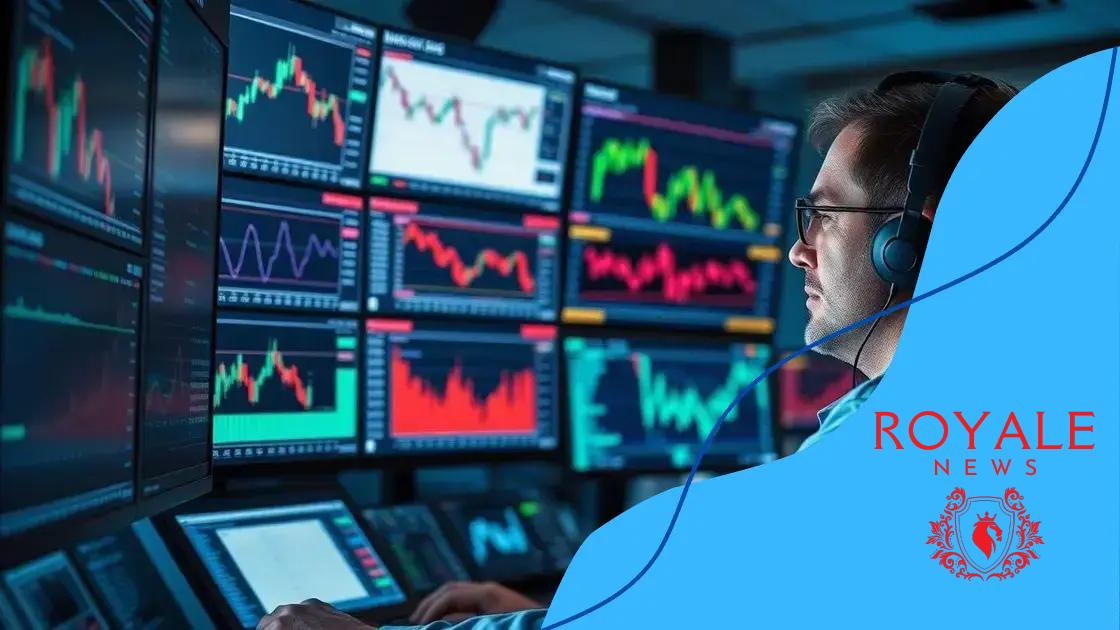Automated trading systems in finance: changing the game

Automated trading systems in finance use algorithms to execute trades rapidly and emotion-free, enhancing efficiency and allowing traders to capitalize on market opportunities while managing strategies continuously.
Automated trading systems in finance are transforming the way traders operate. Have you ever wondered how these systems can boost your trading efficiency? In this article, let’s delve into their mechanics and benefits.
What are automated trading systems?
Automated trading systems are tools designed to execute trades in financial markets without manual intervention. These systems analyze market conditions and place trades based on predefined criteria. By leveraging technology, traders can enhance their strategies and potentially increase profitability.
Key Features of Automated Trading Systems
There are several critical features that define automated trading systems, making them popular among investors:
- Speed: These systems can react to market changes in milliseconds, far outpacing human traders.
- Emotionless Trading: Automated systems operate based on algorithms, eliminating emotional biases that can affect decision-making.
- Backtesting: Traders can test their strategies using historical data, evaluating performance before implementing real trades.
- 24/7 Trading: Unlike human traders, automated systems can operate continuously, allowing for trading at all hours.
The automation of trading processes allows for a more efficient and disciplined approach. With automated trading systems, traders can set their preferences and let the system manage their trades with minimal intervention. This can be particularly beneficial in volatile markets where quick decisions are crucial.
Moreover, many systems allow for customization, enabling traders to develop strategies that suit their specific needs. Whether a trader favors day trading, swing trading, or long-term investments, there are automated solutions to fit various approaches.
Types of Automated Trading Systems
There are various types of automated trading systems, each designed for different trading styles:
- High-Frequency Trading: These systems make numerous trades per second, capitalizing on small price changes.
- Algorithmic Trading: This involves trading based on complex algorithms that consider various market factors.
- Copy Trading: Traders can mimic the trades of experienced investors, allowing for a more hands-off approach.
- Market Making: Automated systems can provide liquidity to markets by continuously buying and selling.
Understanding the variety of available systems helps traders choose the right one for their goals. The choice depends on the trading style, risk tolerance, and investment strategy.
By utilizing automated trading systems, traders can achieve greater consistency, freeing up time to focus on strategy enhancement and other market research activities. The systems do the heavy lifting, allowing traders to concentrate on refining their approaches without getting bogged down in each trade.
How automated trading systems work
Understanding how automated trading systems work is crucial for anyone interested in trading. These systems rely on algorithms that analyze market data and execute trades without human intervention. The core functionality of these systems revolves around three main components: data analysis, strategy implementation, and trade execution.
Data Analysis
The first step in an automated trading system involves analyzing vast amounts of market data. Algorithms sift through historical and real-time data to identify trends and patterns. This data can include price movements, trading volume, and other market indicators. By processing this information, the system can predict potential future movements, enabling timely trades.
Strategy Implementation
Next, the system implements a specific trading strategy. Traders can program different strategies based on their goals. Common strategies include:
- Trend following: This strategy aims to capitalize on existing market momentum.
- Mean reversion: This strategy bets that prices will return to their average levels.
- Arbitrage: This exploits price discrepancies between different markets or instruments.
- Market making: This involves providing liquidity by placing both buy and sell orders.
Once a strategy is set, the automated trading system can operate without ongoing human control. This allows traders to stay engaged in multiple markets simultaneously.
Trade Execution
The last component of these systems is effective trade execution. Once a signal is generated by the analysis and strategy phases, the system quickly executes the trade. The speed of execution is vital; even a small delay can affect profitability. Automated systems can place orders in milliseconds, trying to capture the best prices available.
Additionally, most systems include risk management features. These features can manage stop losses, take profits, and adjust position sizes automatically based on market conditions. By continuously monitoring the market, the system can adapt to fluctuating scenarios, helping to protect the trader’s investment.
In summary, automated trading systems efficiently operate by using sophisticated algorithms that analyze data, follow specific strategies, and execute trades instantly. This level of automation not only streamlines the trading process but also provides traders with a competitive edge in fast-paced markets.
Benefits of using automated trading

The benefits of using automated trading systems are significant, making them appealing to both new and experienced traders. These systems offer a variety of advantages that can enhance trading performance and efficiency.
Increased Efficiency
One of the main benefits is the increased efficiency of trade execution. Automated systems can process data and execute trades in milliseconds, which allows traders to take advantage of market opportunities that arise quickly. This speed can make a big difference in competitive markets.
Emotion-Free Trading
Emotion-free trading is another vital advantage. Traders often let emotions drive their decisions, which can lead to poor outcomes. Automated trading systems follow predefined rules without emotional influence. This helps maintain discipline and adherence to trading strategies, promoting better decision-making.
Consistency and Discipline
With the ability to execute trades consistently, automated trading systems foster discipline in trading. The system can manage strategies around the clock, ensuring that opportunities are not missed even when the trader is unavailable. This leads to more structured trading practices.
- Backtesting capabilities: Traders can test their strategies against historical data to evaluate potential performance before investing real money.
- Diversification: Automated systems can manage multiple accounts or strategies simultaneously, spreading risk and increasing potential profit opportunities.
- Reduced time commitment: With trades being executed automatically, traders can save time on market analysis and focus on refining their strategies instead.
The ability to backtest provides an opportunity to refine strategies based on past market conditions. This feature allows traders to analyze the performance of their strategies before implementing them in real-time. Therefore, this reduces risks associated with untested approaches.
Diversification is another critical benefit. Automated trading systems can manage multiple accounts or strategies at once, allowing traders to spread risk and explore various markets simultaneously. This flexibility can lead to greater overall returns.
In essence, the use of automated trading systems can lead to improved trading performance, characterized by speed, consistency, and discipline. By removing emotional factors and optimizing efficiency, these systems present a powerful tool for modern traders.
Challenges in automated trading
While automated trading systems offer many benefits, they also come with challenges that traders should be aware of. These challenges can impact trading performance and should be considered before implementing such systems.
Technical Issues
One significant challenge is the potential for technical issues. Automated systems can be vulnerable to software bugs or hardware malfunctions. A glitch during a trade can lead to considerable losses. Therefore, it’s essential for traders to regularly monitor their systems and conduct maintenance.
Market Conditions
Market conditions can change rapidly, and automated trading systems may not always adapt effectively. A strategy that worked well in one market environment may fail in another. Traders must ensure that their systems are flexible enough to adjust to new market data and trends. Regular updates and modifications are necessary to keep strategies relevant.
Over-Optimization
Over-optimization is another common pitfall. This occurs when a system is fine-tuned to perform exceptionally well on historical data but fails when faced with real-time market conditions. Traders should be cautious not to create a system that is too tailored to past data and ultimately does not perform as expected.
- Data Overload: The sheer volume of data in the markets can overwhelm some automated systems, leading to unintended consequences.
- Psychological Factors: While automation reduces emotional trading, the reality of potential losses can still affect a trader’s mindset regarding automation.
- Regulatory Challenges: Automated trading must comply with regulations that vary by country. Keeping up with these regulations can be tricky for many traders.
Additionally, the market’s fast pace can lead to data overload. If a system receives too much information, it can struggle to process it all in a timely manner, making it harder to execute trades effectively.
Psychological factors also play a role, as traders may still feel anxious about relying entirely on automation. This can lead to second-guessing or changing strategies mid-trade, ultimately affecting performance.
Finally, the regulatory landscape for automated trading is ever-changing. Compliance with different regulations around the world can be challenging. Traders need to stay informed about legal requirements to avoid penalties and ensure proper functioning.
Future trends in automated trading
The future of automated trading is exciting and full of potential. As technology evolves, so do the capabilities of these trading systems. It’s important to understand what trends are shaping the next generation of automated trading.
Artificial Intelligence and Machine Learning
One of the most significant trends is the integration of artificial intelligence (AI) and machine learning. These technologies enable systems to learn from past data, adapting to market changes over time. This adaptability allows traders to maximize their strategies and improve performance.
Improved Data Analytics
Another key trend is enhanced data analytics. As data sources continue to expand, automated trading systems will be able to access and analyze more information than ever. Improved analytics allow for more accurate predictions and better-informed trading decisions.
- Big Data Insights: Automated systems will use big data techniques to process vast amounts of market data quickly.
- Sentiment Analysis: By analyzing social media and news, systems can gauge market sentiment and react accordingly.
- Advanced Algorithms: Developments in algorithms will lead to more sophisticated trading strategies that account for various market conditions.
In addition to these innovations, the growing importance of cloud computing will play a crucial role. Cloud technology provides traders with greater computational power and scalability, allowing systems to handle large data sets efficiently. This means that traders can run more complex models without worrying about hardware limitations.
Furthermore, regulatory trends are also shaping the future landscape of automated trading. As regulations develop, systems will need to be designed to comply with new requirements. This may lead to an emphasis on transparency and risk management in automated systems.
Increased Accessibility
Finally, as technology becomes more accessible, more traders will have the opportunity to use automated trading systems. This democratization of trading technology means that individual investors will be able to compete with larger institutions, leveling the playing field.
In summary, the future trends in automated trading are focused on leveraging AI, improving data analytics, and ensuring regulatory compliance. These trends will not only enhance trading strategies but also increase accessibility for a wider range of investors. As these technologies grow, they will reshape the landscape of trading, offering new opportunities for all traders.
FAQ – Frequently Asked Questions about Automated Trading Systems
What are automated trading systems?
Automated trading systems are software platforms that execute trades on behalf of traders based on programmed algorithms and market conditions.
What are the main benefits of using automated trading?
The main benefits include speed, emotion-free trading, increased efficiency, and the ability to execute complex strategies continuously.
What challenges might I face with automated trading?
Challenges include technical issues, market volatility, data overload, and the need for regular updates to adapt to changing market conditions.
How will future trends affect automated trading?
Future trends like artificial intelligence and improved data analytics will enhance trading strategies, making them more adaptive and accessible to various investors.





